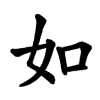Definify.com
Definition 2025
來
來
| ||||||
|---|---|---|---|---|---|---|
Translingual
| 来 | |
| 來 | |
| 来 | |
| 來 |
| Stroke order | |||
|---|---|---|---|

| |||
| Stroke order | |||
|---|---|---|---|

| |||
Han character
來 (radical 9 人+6, 8 strokes, cangjie input 木人人 (DOO), four-corner 40908, composition ⿻木从)
Descendants
References
- KangXi: page 101, character 16
- Dai Kanwa Jiten: character 581
- Dae Jaweon: page 214, character 8
- Hanyu Da Zidian: volume 1, page 141, character 8
- Unihan data for U+4F86
Chinese
| trad. | 來 | |
|---|---|---|
| simp. | 来 | |
Glyph origin
| Historical forms of the character 來
| ||||||||||||||||||||||||||||||||||||||||||||||||||||||||||||||||||||||||||||||||||||||||||||||||||||||||||||||||||||||||||||||||||||||||||||||||||||||||||||||||||||||||||||||||||||||||||||||||||||||||||||||||||||||||||||
|---|---|---|---|---|---|---|---|---|---|---|---|---|---|---|---|---|---|---|---|---|---|---|---|---|---|---|---|---|---|---|---|---|---|---|---|---|---|---|---|---|---|---|---|---|---|---|---|---|---|---|---|---|---|---|---|---|---|---|---|---|---|---|---|---|---|---|---|---|---|---|---|---|---|---|---|---|---|---|---|---|---|---|---|---|---|---|---|---|---|---|---|---|---|---|---|---|---|---|---|---|---|---|---|---|---|---|---|---|---|---|---|---|---|---|---|---|---|---|---|---|---|---|---|---|---|---|---|---|---|---|---|---|---|---|---|---|---|---|---|---|---|---|---|---|---|---|---|---|---|---|---|---|---|---|---|---|---|---|---|---|---|---|---|---|---|---|---|---|---|---|---|---|---|---|---|---|---|---|---|---|---|---|---|---|---|---|---|---|---|---|---|---|---|---|---|---|---|---|---|---|---|---|---|---|---|---|---|---|---|---|---|---|---|---|---|---|---|---|---|---|
| Oracle bone script | Bronze inscriptions | Large seal script | Small seal script | |||||||||||||||||||||||||||||||||||||||||||||||||||||||||||||||||||||||||||||||||||||||||||||||||||||||||||||||||||||||||||||||||||||||||||||||||||||||||||||||||||||||||||||||||||||||||||||||||||||||||||||||||||||||||
 |
 |
 |
 |
|||||||||||||||||||||||||||||||||||||||||||||||||||||||||||||||||||||||||||||||||||||||||||||||||||||||||||||||||||||||||||||||||||||||||||||||||||||||||||||||||||||||||||||||||||||||||||||||||||||||||||||||||||||||||
| ||||||||||||||||||||||||||||||||||||||||||||||||||||||||||||||||||||||||||||||||||||||||||||||||||||||||||||||||||||||||||||||||||||||||||||||||||||||||||||||||||||||||||||||||||||||||||||||||||||||||||||||||||||||||||||
|
References:
Mostly from Richard Sears' Chinese Etymology site (authorisation),
| ||||||||||||||||||||||||||||||||||||||||||||||||||||||||||||||||||||||||||||||||||||||||||||||||||||||||||||||||||||||||||||||||||||||||||||||||||||||||||||||||||||||||||||||||||||||||||||||||||||||||||||||||||||||||||||
| Characters in the same phonetic series (來) (Zhengzhang, 2003) | |
|---|---|
| Old Chinese | |
| 來 | *m·rɯːɡ |
| 萊 | *rɯː, *rɯːs |
| 淶 | *rɯː |
| 徠 | *rɯː, *rɯːs |
| 崍 | *rɯː |
| 郲 | *rɯː, *ruːlʔ, *ruːlʔ |
| 騋 | *rɯː |
| 猍 | *rɯː |
| 鯠 | *rɯː |
| 鶆 | *rɯː |
| 庲 | *rɯː |
| 棶 | *rɯː |
| 斄 | *rɯː, *rɯ |
| 逨 | *rɯː, *rɯːs |
| 麳 | *rɯː |
| 唻 | *rɯːʔ, *rrɯː |
| 賚 | *rɯːs |
| 睞 | *rɯːs |
| 勑 | *rɯːs |
| 誺 | *rɯːs, *r̥ʰɯ, *r̥ʰɯs, *r̥ʰɯs |
| 倈 | *rɯ |
| 憖 | *ŋrɯns |
| 猌 | *ŋrɯns |
| 麥 | *mrɯːɡ |
It is shaped like corn or wheat (similar to 禾), symbolising the coming of the crops. Its Old Chinese pronunciation begins with “*mr-”. The meaning “come” was originally represented by 麥 (OC *mrɯːɡ, “wheat”), adding a radical meaning “footprint” or “walk slowly”. Their meanings have interchanged. M-remaining is 麥, l-remaining is 來.
Etymology
From Proto-Sino-Tibetan *la-j ~ ra.
Pronunciation
- Mandarin
- Cantonese (Jyutping): loi4
- Hakka (Sixian, PFS): lòi
- Min Dong (BUC): lì / lài
- Min Nan
- Wu (Wiktionary): le (T3)
- Mandarin
- (Standard Chinese, Beijing)+
- Pinyin:
- Zhuyin: ㄌㄞˊ
- Wade-Giles: lai2
- Gwoyeu Romatzyh: lai
- IPA (key): /laɪ̯³⁵/
-

- (Standard Chinese, Beijing)+
- Cantonese
- (Standard Cantonese, Guangzhou)+
- Jyutping: loi4
- Yale: lòih
- Cantonese Pinyin: loi4
- IPA (key): /lɔːi̯²¹/
- (Standard Cantonese, Guangzhou)+
- Hakka
- (Sixian, incl. Miaoli and Meinong)
- Pha̍k-fa-sṳ: lòi
- Hakka Romanization System: loiˇ
- Hagfa Pinyim: loi2
- IPA: /lo̯i¹¹/
- (Sixian, incl. Miaoli and Meinong)
- Min Dong
- (Fuzhou)
- Bàng-uâ-cê: lì / lài
- IPA (key): /l̃i⁵³/, /l̃ai⁵³/
- Note: lì - colloquial; lài - literary.
- (Fuzhou)
- Min Nan
- (Hokkien)
- Pe̍h-ōe-jī: lâi
- Tâi-lô: lâi
- Phofsit Daibuun: laai
- IPA (Xiamen): /laɪ²⁴/
- IPA (Quanzhou): /laɪ²⁴/
- IPA (Zhangzhou): /laɪ¹³/
- IPA (Taipei): /laɪ²⁴/
- IPA (Kaohsiung): /laɪ²³/
- (Teochew)
- Peng'im: lai5
- Pe̍h-ōe-jī-like: lâi
- IPA (key): /lai⁵⁵/
- (Hokkien)
- Wu
- (Shanghainese)
- Wiktionary: le (T3)
- IPA (key): /lᴇ²³/
- (Shanghainese)
| Rime | |
|---|---|
| Character | 來 |
| Reading # | 1/1 |
| Initial (聲) | 來 (37) |
| Final (韻) | 咍 (41) |
| Tone (調) | Level (Ø) |
| Openness (開合) | Open |
| Division (等) | I |
| Fanqie | 洛哀切 |
| Reconstructions | |
| Zhengzhang Shangfang |
/lʌi/ |
| Pan Wuyun |
/ləi/ |
| Shao Rongfen |
/lɒi/ |
| Edwin Pulleyblank |
/ləj/ |
| Li Rong |
/lᴀi/ |
| Wang Li |
/lɒi/ |
| Bernard Karlgren |
/lɑ̆i/ |
| Expected Mandarin Reflex |
lái |
| Baxter-Sagart system 1.1 (2014) | ||
|---|---|---|
| Character | 來 | 來 |
| Reading # | 1/2 | 2/2 |
| Modern Beijing (Pinyin) |
lái | lái |
| Middle Chinese |
‹ loj › | ‹ loj › |
| Old Chinese |
/*mə.rˤək/ (> *mə.rˤə) | /*mə.rˤək/ (> *rˤə) |
| English | a kind of wheat | come |
Notes for Old Chinese notations in the Baxter-Sagart system: * Parentheses "()" indicate uncertain presence; | ||
| Zhengzhang system (2003) | |
|---|---|
| Character | 來 |
| Reading # | 1/1 |
| No. | 7598 |
| Phonetic component |
來 |
| Rime group |
之 |
| Rime subdivision |
0 |
| Corresponding MC rime |
|
| Old Chinese |
/*m·rɯːɡ/ |
Definitions
來
- to come; to arrive
- Antonyms: 去 (qù)
- to happen; to occur
- to do (specific meaning depending on the context)
- since
- next; coming; future
- (after a number) about; approximately; around
- Used after a verb of motion to indicate movement toward the speaker.
- Used before a verb to express volition.
- Used with 不 or 得 to express capability.
- Used after numerals in colloquial lists.
- Meaningless particle for rhythmic purposes.
- A surname.
Synonyms
| Dialectal synonyms of 來 (“to come”) | ||
|---|---|---|
| Variety | Location | Words |
| Classical Chinese | 來 | |
| Formal (Written Standard Chinese) | 來 | |
| Mandarin | Beijing | 來 |
| Cantonese | Guangzhou | 嚟 |
| Hong Kong | 嚟 | |
| Taishan | 來 | |
Compounds
|
|
|
Japanese
Kanji
(“Jinmeiyō” kanji used for names, kyūjitai kanji, shinjitai form 来)
Usage notes
Not used in modern Japanese, except in some names. In regular text, the shinjitai character 来 is used instead.
Readings
Compounds
Etymology 1
Pronunciation
Prefix
來 (kyūjitai kanji, shinjitai kanji 来, hiragana らい, romaji rai-)
- Kyūjitai spelling of 来 next, coming (week, year, etc.)
- 來年、來週
- rainen, raishū
- next year, next week
- 來週月曜日に會いましょう。
- Raishū getsuyōbi ni aimashō.
- Let's meet Monday next. / Let's meet this coming Monday.
- 來年、來週
Suffix
來 (kyūjitai kanji, shinjitai kanji 来, hiragana らい, romaji -rai)
- Kyūjitai spelling of 来 since, in (a span of time)
- 三年來あれを見ていない。
- San nen rai are o mite inai.
- I haven't seen that in three years / since three years ago.
- 三年來あれを見ていない。
Etymology 2
From Old Japanese. The verb ku is one of the few monosyllabic verb roots in Japanese. This developed into kuru in modern Japanese.
Pronunciation
Verb
來 (kyūjitai kanji, shinjitai kanji 来, irregular conjugation, hiragana く, romaji ku)
- (obsolete) to approach ones position from a remote location: to come
























































































































































































































